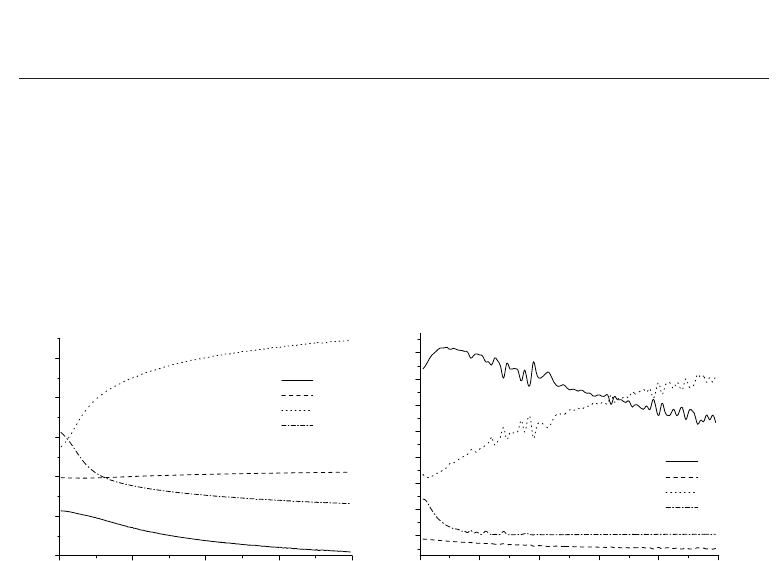Ahsan A. (ed.) Evaporation, Condensation and Heat transfer
Подождите немного. Документ загружается.


0
Different Approaches for Modelling
of Heat Transfer in Non-Equilibrium
Reacting Gas Flows
E.V. Kustova and E.A. Nagnibeda
Saint Petersburg State University
Russia
1. Introduction
Modelling of heat transfer in non-equilibrium reacting gas flows is very important and
promising for many up-to-date practical applications. Thus, calculation of heat fluxes is
needed to solve the problem of heat protection for the surfaces of space vehicles entering
into planet atmospheres.
In high-temperature and hypersonic flows of gas mixtures, the energy exchange between
translational and internal degrees of freedom, chemical reactions, ionization and radiation
result in violation of thermodynamic equilibrium. Therefore the non-equilibrium effects
become of importance for a correct prediction of gas flow parameters and transport properties.
The first attempt to take into account the excitation of internal degrees of freedom in
calculations for the transport coefficients was made in 1913 by E. Eucken Eucken (1913),
who introduced a phenomenological correction into the formula for the thermal conductivity
coefficient. Later on, stricter analysis for the influence of the excitation of internal degrees
of freedom of molecules on heat and mass transfer was based on the k inetic theory of gases.
Originally, in the papers concerning kinetic theory models for transport properties, mainly
minor deviations from the local thermal equilibrium were considered for non-reacting gases
Ferziger & Kaper (1972); Wang Chang & Uhlenbeck (1951) and for mixtures with chemical
reactions Ern & Giovangigli (1994). In this approach non-equilibrium effects were taken
into account in transport equations by introducing supplementary kinetic coefficients: the
coefficient of volume viscosity in the expression for the pressure tensor and corrections to the
thermal conductivity coefficient in the equation for the total energy flux. Such a description
of the real gas effects becomes insufficient under the conditions of finite (not weak) deviations
from the equilibrium, in which the energy exchange between some degrees of freedom and
some part of chemical reactions proceed simultaneously with the variation of gas-dynamic
parameters. In this case characteristic times for gas-dynamic and relaxation processes become
comparable, and therefore the equations for macroscopic parameters of the flow should
be coupled to the equations of physical-chemical kinetics. The transport coefficients, heat
fluxes, diffusion velocities directlydepend on non-equilibrium distributions, which may differ
substantially from the Boltzmann thermal equilibrium distribution. In this situation, the
estimate for the impact of non-equilibrium kinetics on gas-dynamic parameters of a flow
21

2 Will-be-set-by-IN-TECH
and its dissipative properties becomes especially important. In recent years, these problems
receive much attention, and new results have been obtained in this field on the basis of the
generalized Chapman-Enskog method Nagnibeda & Kustova (2009), see also references in
Nagnibeda & Kustova (2009). The kinetic theory makes it possible to develop mathematical
models of a flow under different non-equilibrium conditions, i.e. to obtain closed systems of
the non-equilibrium flow equations and to elaborate calculation procedures for transport and
relaxation properties.
In the present chapter, on the basis of the kinetic theory developed in Nagnibeda & Kustova
(2009), the mathematical models for calculation of heat tr ansfer in strong non-equilibrium
reacting mixtures are proposed for different conditions in a flow.
2. Theoretical models
The theoretical models adequately describing physical-chemical kinetics and transport
properties in a flow depend on relations between relaxation times of various kinetic processes.
Experimental data show the significant difference in relaxation times of various processes.
At the high temperature conditions which are typical just behind the shock front, the
equilibrium over the translational and rotational degrees of freedom is established for a
substantially shorter time than that of vibrational relaxation and chemical reactions, and
therefore the following relation takes place Phys-Chem (2002); Stupochenko et al. (1967):
τ
tr
< τ
rot
τ
vibr
< τ
react
∼ θ.(1)
In (1), τ
tr
, τ
rot
, τ
vibr
and τ
react
are the the relaxation times for the translational, rotational
and vibrational degrees of freedom, and the characteristic time for chemical reactions; θ is
the mean time of the variation of gas-dynamics parameters. In this case for the description
of the non-equilibrium flow it is necessary to consider the equations of the state-to-state
vibrational and chemical kinetics coupled to the gas dynamic equations. It is the most detailed
description of the non-equilibrium flow. Transport properties in the flow depend not only
on gas temperature and mixture composition but also on all vibrational level populations of
different species Kustova & Nagnibeda (1998).
More simple models of the flow are based on quasi-stationary multi-temperature or
one-temperature vibrational distributions. In the vibrationally excited gas at moderate
temperatures, the near-resonant vibrational energy exchanges between molecules of the same
chemical species occur much more frequently compared to the non-resonant transitions
between different molecules as well as transfers of vibrational energy to the translational and
rotational ones and chemical reactions:
τ
tr
< τ
rot
< τ
VV
1
τ
VV
2
< τ
TRV
< τ
react
∼ θ.(2)
Here τ
VV
1
, τ
VV
2
, τ
TRV
are, respectively, the mean times for the VV
1
vibrational energy
exchange between molecules of the same species, VV
2
vibrational transitions between
molecules of different species and TRV transitions of the vibrational energy into other modes.
Under this condition quasi-stationary (multi-temperature) distributions over the vibrational
levels establish due to rapid energy exchanges, and equations for vibrational level populations
are reduced to the equations for vibrational temperatures for different chemical species.
440
Evaporation, Condensation and Heat Transfer

Different Approaches for Modelling of Heat Transfer in Non-Equilibrium Reacting Gas Flows 3
Heat and mass transfer are specified by the gas temperature, molar fractions of species and
vibrational temperatures of molecular components Chikhaoui et al. (1997).
For tempered reaction regime, with the chemical reaction rate considerably lower than that
for the internal energy relaxation, the following characteristic time relation takes place:
τ
tr
< τ
int
τ
react
∼ θ,(3)
τ
int
is the mean time for the internal energy relaxation. Under this condition, the
non-equilibrium chemical kinetics can be described on the basis of the maintaining thermal
equilibrium one-temperature Boltzmann distributions over internal energies of molecular
species while transport properties are defined by the gas temperature and molar fractions of
mixture components Ern & Giovangigli (1994); Nagnibeda & Kustova (2009). The influence
of electronic excitation of atoms and molecules on the transport properties under the last
condition is also considered in Kustova & Puzyreva (2009).
Finally, if all relaxation processes and chemical reactions proceed faster than gas-dynamic
parameters vary, the relaxation times satisfy the relation:
τ
tr
< τ
int
< τ
react
θ.(4)
Under this condition, on the time scale θ a gas flow can be assumed thermally and
chemically equilibrium or weakly non-equilibrium (Brokaw (1960); Butler & Brokaw (1957);
Vallander et al. (1977)). In this case the closed system of governing equations of a flow
contains only conservation equations, and non-equilibrium effects in a viscous flow manifest
themselves mainly in transport coefficients.
In the present contribution, for all these approaches, on the basis of the rigorous kinetic
theory methods, we propose the closed sets of governing equations of a flow, expressions for
transport and relaxation terms in these equations and formulas for the calculation of transport
coefficients. The results of applications of proposed models for particular flows are briefly
discussed. The comparison of the results obtained for heat transfer in different approaches
behind shock waves, in nozzle flows, in the non-equilibrium boundary layer and in a shock
layer near the re-entering body is discussed.
2.1 State-to-state model
2.1.1 Distribution functions and governing equations
The mathematical models of transport properties in non-equilibrium flows of reacting viscous
gas mixtures are based on the first-order solutions of the kinetic equations for distribution
functions f
cij
(r, u, t) over chemical species c , vibrational i and rotational j energy levels,
particle velocities u, coordinates r and time t. In the case of strong deviations from thermal
and chemical equilibrium in a flow, the kinetic processes may be divided for rapid and slow
ones and the kinetic equations for f
cij
(r, u, t) canbewrittenintheformNagnibeda&Kustova
(2009)
∂ f
cij
∂t
+ u
c
·∇f
cij
=
1
ε
J
rap
cij
+ J
sl
cij
,(5)
where J
rap
cij
, J
sl
cij
are the collision operators for rapid and slow processes, respectively, the small
parameter ε represents the ratio of the characteristic times for rapid and slow processes ε
=
τ
rap
/τ
sl
∼ τ
rap
/θ 1. Under the condition (5), the integral operator for rapid processes
441
Different Approaches for Modelling of Heat Transfer in Non-Equilibrium Reacting Gas Flows

4 Will-be-set-by-IN-TECH
J
rap
cij
describes elastic collisions and rotational energy exchange whereas the operator for slow
processes J
sl
cij
describes the vibrational energy exchange and chemical reactions:
J
rap
cij
= J
tr
cij
+ J
rot
cij
,
J
sl
cij
= J
vibr
cij
+ J
react
cij
.(6)
The integral operators (6) are given in Ern & Giovangigli (1994); Nagnibeda & Kustova (2009).
For the solution of the kinetic equations (5), (6) modification of the Chapman-Enskog method
for rapid and slow processes Chikhaoui et al. (1997); Kustova & Nagnibeda (1998) is used.
This method makes it possible to derive governing equations of the flow, expressions for
the dissipative and relaxation terms in these equations and algorithms for the calculation of
transport and reaction rate coefficients. The solution of the equations (5), (6) is sought as the
generalized Chapman-Enskog series in the small parameter ε.
The solution of the kinetic equations in the zero-order approximation
J
rap(0 )
cij
= 0(7)
is specified by the independent collision invariants of the most frequent collisions which
define rapid processes. These invariants include the momentum and particle total energy
which are conserved at any collision, and additional invariants for the most probable collisions
which are given by any value independent of the velocity and rotational level j and depending
arbitrarily on the vibrational level i and chemical species c. The additional invariants appear
due to the fact that vibrational energy exchange and chemical reactions are supposed to be
frozen in rapid processes. Based on the above set of the collision invariants, the zero-order
distribution function takes the form
f
(0)
cij
=
m
c
2πkT
3/2
s
ci
j
n
ci
Z
rot
ci
(T)
exp
−
m
c
c
2
c
2kT
−
ε
ci
j
kT
(8)
Here, n
ci
is the population of vibrational level i of species c, c
c
= u
c
− v, v is the macroscopic
velocity, ε
ci
j
is the rotational energy of the molecule at j-th rotational and i-th vibrational
levels, T is the gas temperature, m
c
is the molecular mass, k is the Boltzmann constant, s
ci
j
is the rotational statistical weight, Z
rot
ci
is the rotational partition function. For the rigid rotator
model, ε
ci
j
= ε
c
j
, Z
rot
ci
= Z
rot
c
=
8π
2
I
c
kT
σh
2
, I
c
is the moment of inertia, h is the Planck constant, σ is
the symmetry factor.
The distribution functions (8) are specified by the macroscopic gas parameters: n
ci
(r, t)
(c = 1, ..., L, i = 0, 1, ..., L
c
, L is the number of chemical species, L
c
is the number of excited
vibrational levels in species c), T
(r, t),andv(r, t) which correspond to the set of the collision
invariants of rapid processes.
The closed set of equations for the macroscopic parameters n
ci
(r, t), T(r, t),andv(r, t) follows
from the kinetic equations and includes the conservation equations of momentum and total
energy coupled to the relaxation equations of detailed state-to-state vibrational and chemical
442
Evaporation, Condensation and Heat Transfer

Different Approaches for Modelling of Heat Transfer in Non-Equilibrium Reacting Gas Flows 5
kinetics Nagnibeda & Kustova (2009):
dn
ci
dt
+ n
ci
∇· v + ∇· (n
ci
V
ci
)=R
ci
, c = 1, ..., L, i = 0, ..., L
c
,(9)
ρ
dv
dt
+ ∇· P = 0, (10)
ρ
dU
dt
+ ∇· q + P : ∇v = 0. (11)
Here P is the pressure tensor, q is the total energy flux, V
ci
are diffusion velocities of molecules
at different vibrational states, U is the total energy per unit mass:
ρU
=
3
2
nkT
+ ρE
rot
+
∑
ci
ε
c
i
n
ci
+
∑
c
ε
c
n
c
.
E
rot
is the rotational energy per unit mass, ε
c
i
is the vibrational energy of a molecule of species
c at the i-th vibrational level, ε
c
is the energy of formation of the particle of species c.
The source terms in the equations (9) are expressed via the integral operators of slow
processes:
R
ci
=
∑
j
J
sl
cij
d u
c
= R
vibr
ci
+ R
react
ci
. (12)
and characterize the variation of the vibrational level populations and atomic number
densities caused by different vibrational energy exchanges and chemical reactions.
For this approach, the vibrational level populations are included to the set of main
macroscopic parameters, and the equations for their calculation are coupled to the equations
of gas dynamics. Particles of various chemical species in different vibrational states represent
the mixture components, and the corresponding equations contain the diffusion velocities V
ci
of molecules at different vibrational states. Thus the diffusion of vibrational energies is the
peculiar feature of diffusion processes in the state-to-state approximation.
2.1.2 Transport properties
In the zero-order approximation of Chapman-Enskog method
P
(0)
= nkTI, q
(0)
= 0, V
(0)
ci
= 0 ∀ c, i, (13)
I is the unity tensor.
The set of governing equations in this case describes the detailed state-to-state vibrational and
chemical kinetics in an inviscid non-conductive gas mixture flow in the Euler approximation
Nagnibeda & Kustova (2009). Taking into account the first-order approximation makes it
possible to consider dissipative properties in a non-equilibrium viscous gas.
The first-order distribution functions can be written in the following structural form
Kustova & Nagnibeda (1998):
f
(1)
cij
= f
(0)
cij
−
1
n
A
cij
·∇ln T −
1
n
∑
dk
D
dk
cij
· d
dk
−
1
n
B
cij
: ∇v −
1
n
F
cij
∇·v −
1
n
G
cij
. (14)
443
Different Approaches for Modelling of Heat Transfer in Non-Equilibrium Reacting Gas Flows

6 Will-be-set-by-IN-TECH
The functions A
cij
, D
dk
cij
, B
cij
, F
cij
,andG
cij
depend on the peculiar velocity c
c
and the flow
parameters: temperature T,velocityv, and vibrational level populations n
ci
, and satisfy the
linear integral equations with linearized operator for rapid processes; d
ci
are the diffusive
driving forces:
d
ci
= ∇
n
ci
n
+
n
ci
n
−
ρ
ci
ρ
∇ ln p. (15)
The transport kinetic theory in the state-to-state approximation was developed, for the first
time, in Kustova & Nagnibeda (1998) and is given also in Nagnibeda & Kustova (2009). The
expressions for the transport terms in the equations (9)-(11) in the first order approximation
are derived on the basis of the distribution functions (14).
The viscous stress tensor is described by the expression:
P
=(p − p
rel
)I − 2ηS − ζ ∇·vI. (16)
Here, p
rel
is the relaxation pressure, η and ζ are the coefficients of shear and bulk viscosity,
S is the deformation rate tensor. The additional terms connected to the bulk viscosity and
relaxation pressure appear in the diagonal terms of the stress tensor in this case due to rapid
inelastic TR exchange between the translational and rotational energies. The existence of the
relaxation pressure is caused also by slow processes of vibrational and chemical relaxation. If
all slow relaxation processes in a system disappear, then p
rel
= 0.
The d iffusion velocity of molecular components c at the vibrational level i is specified in the
state-to-state approach by the expression Kustova & Nagnibeda (1998); Nagnibeda & Kustova
(2009):
V
ci
= −
∑
dk
D
cidk
d
dk
− D
Tci
∇ ln T, (17)
where D
cidk
and D
Tci
are the multi-component diffusion and thermal diffusion coefficients for
each chemical and vibrational species.
The total energy flux in the first-order approximation has the form:
q
= −λ
∇T − p
∑
ci
D
Tci
d
ci
+
∑
ci
5
2
kT
+ ε
ci
rot
+ ε
c
i
+ ε
c
n
ci
V
ci
, (18)
where λ
tr
+ λ
rot
is the thermal conductivity coefficient, ε
ci
rot
is the mean rotational energy.
The coefficients λ
tr
and λ
rot
are responsible for the energy transfer associated with the most
probable processes which, in the present case, are the elastic collisions and inelastic TR- and
RR rotational energy exchanges. In the state-to-state approach, the transport of the vibrational
energy is described by the diffusion of vibrationally excited molecules rather than the thermal
conductivity. In particular, the diffusion of the vibrational energy is simulated by introducing
the independent diffusion coefficients for each vibrational state. It should be noted that
all transport coefficients are specified by the cross sections of rapid processes excepting the
relaxation pressure depending also on the cross sections of slow processes of vibrational
relaxation and chemical reactions.
From the expressions (17), (18), it is seen that the energy flux and diffusion velocities include
along with the gradients of temperature and atomic number densities also the gradients of
all vibrational level populations with multi-component diffusion coefficients depending on
the vibrational levels of colliding molecules. In the state-to-state approach, the transport of
444
Evaporation, Condensation and Heat Transfer

Different Approaches for Modelling of Heat Transfer in Non-Equilibrium Reacting Gas Flows 7
vibrational energy is associated with diffusion of vibrationally excited molecules rather than
with heat conductivity. This constitutes the main feature of the heat transfer and diffusion
in the state-to-state approach and the fundamental difference between V
ci
and q and the
diffusion velocities and heat flux obtained on the basis of one-temperature, multi-temperature
or weakly non-equilibrium approaches.
The transport coefficients in the expressions (16)-(18) can be written in terms of functions A
cij
,
D
dk
cij
, B
cij
, F
cij
,andG
cij
:
η
=
kT
10
[
B, B
]
, ζ = kT
[
F, F
]
, p
rel
= kT
[
F, G
]
, (19)
D
cidk
=
1
3n
D
ci
, D
dk
, D
Tci
=
1
3n
D
ci
, A
, λ
=
k
3
[
A, A
]
(20)
Here
[
A, B
]
are the bracket integrals associated with the linearized operator of rapid processes.
They were introduced in Nagnibeda & Kustova (2009) for strongly non-equilibrium reacting
mixtures similarly to those defined in Ferziger & Kaper (1972) for a non-reacting gas mixture
under the conditions for weak deviations from the equilibrium.
For the transport coefficients calculation in the state-to-state approximation, the functions
A
cij
, D
dk
cij
, B
cij
, F
cij
,andG
cij
are expanded into the Sonine polynomials in the reduced
peculiar velocity and those of Waldmann-Trübenbacher in the dimensionless rotational
energy. For the coefficients of these expansions, the linear transport systems are derived in
Kustova & Nagnibeda (1998), Nagnibeda & Kustova (2009), and the transport coefficients are
expressed in terms of the solutions of these systems.
Solving transport linear systems for multi-component mixtures in the state-to-state
approximation is a very complicated technical problem because a great number of equations
should be considered. A simplified technique for the calculation of the transport coefficients
keeping the main advantages of the state-to-state approach, is suggested in Kustova (2001).
The assumptions proposed in this paper made it possible to noticeably reduce the number of
multi-component diffusion and thermal diffusion coefficients and simplify the expressions for
the diffusion velocity and heat flux:
V
ci
= −D
cici
d
ci
− D
cc
∑
k=i
d
ck
−
∑
d=c
D
cd
d
d
− D
Tc
∇ ln T, (21)
q
= −λ
∇T − p
∑
c
D
Tc
d
c
+
∑
ci
5
2
kT
+
ε
ci
j
rot
+ ε
c
i
+ ε
c
n
ci
V
ci
. (22)
Here, d
c
is the classical diffusive driving force associated to chemical species rather than
to the vibrational level Ferziger & Kaper (1972). It is important to emphasize that in these
formulae, after the simplifications, only the s elf-diffusion coefficients D
cici
depend explicitly
on the vibrational quantum number.
The systems for the calculation of the diffusion, viscosity and thermal conductivity coefficients
can be solved using the efficient numerical algorithms elaborated in Ern & Giovangigli (1994)
for the solution of linear algebraic systems, or more traditional techniques used in classical
monographs on the kinetic theory Chapman & Cowling (1970); Ferziger & Kaper (1972);
Hirschfelder et al. (1954).
445
Different Approaches for Modelling of Heat Transfer in Non-Equilibrium Reacting Gas Flows

8 Will-be-set-by-IN-TECH
The expression for the total energy flux may be presented as a sum of contributions of different
processes:
q
= q
HC
+ q
MD
+ q
TD
+ q
DVE
, (23)
where q
HC
, q
MD
, q
TD
,andq
DVE
are, respectively, energy fluxes associated with the heat
conductivity of translational and rotational degrees of freedom, mass diffusion, thermal
diffusion, and the transfer of vibrational energy.
Fig. 1 shows the contribution of different transport processes in the mixture (N
2
,N) to the
heat flux variation behind a shock wave and in a nozzle flow along its axis found in the
state-to-state approach.
0.0 0.5 1.0 1.5 2.0
-2
-1
0
1
2
3
(a)
x, cm
q
D
/q
HC
TD
MD
DVE
0 1020304050
0.0
0.1
0.2
0.3
0.4
0.5
0.6
0.7
HC
TD
MD
DVE
(b)
q
D
/q
x/R
Fig. 1. Ratio of the heat flux due to various processes (α = HC, TD, MD, DVE) to the total
heat flux q (a) behind the shock wave (T
0
= 293 K, p
0
= 100 Pa, M
0
= 15) as a function of the
distance x from the front, and (b) in a conic nozzle (T
∗
= 7000 K, p
∗
= 100 atm) as a function
of x/R ( R is the throat radius).
We can see that the contribution of thermal diffusion to the heat flux is small in both flows
while mass diffusion of atoms is important in the whole flow region. Diffusion of vibrationally
excited molecules plays more important role behind a shock than in a nozzle. Close to the
shock front, heat conduction and mass diffusion compensate each other, and the main role in
the heat transfer belongs to the diffusion of vibrational states. In an expanding flow, q
DVE
is
not negligible only close to the throat (but does not exceed 15%).
The model presented in this section gives a principle possibility to take into account
the state-to-state transport coefficients in numerical simulations of viscous conducting gas
flows under the conditions of strong vibrational and chemical non-equilibrium. The
influence of state-to-state vibrational and chemical kinetics on the dissipative processes
was studied using this model in the flows of binary mixtures of air components
behind shock waves Kustova & Nagnibeda (1999) and in the nozzle expansion of
binary mixtures Kustova, Nagnibeda, Alexandrova & Chikhaoui (2002) and 5-component air
mixture Capitelli et al. (2002). However, even taking into account proposed simplifications of
transport coefficients mentioned above, the problem of implementation of the state-to-state
model of transport properties in numerical fluid dynamic codes for the flows of
multi-component reacting mixtures remains time consuming and numerically expensive for
applications particularly if many test cases should be considered. Indeed, the solution of
the fluid dynamics equations coupled to the equations of the state-to-state vibrational and
chemical kinetics in a flow requires numerical simulation of a great number of equations
446
Evaporation, Condensation and Heat Transfer

Different Approaches for Modelling of Heat Transfer in Non-Equilibrium Reacting Gas Flows 9
for the vibrational level populations of all molecular species. Moreover, the closed system
of macroscopic equations in the state-to-state approach includes the state-dependent rate
coefficients of all vibrational energy transitions and chemical reactions. Experimental
and theoretical data on these rate coefficients and especially on the cross sections of
inelastic processes are rather scanty. Due to the above problems, simpler models based on
quasi-stationary vibrational distributions are rather attractive for practical applications.
Such approaches are considered in the next section.
2.2 Quasi-stationary models
In quasi-stationary approaches, the vibrational level populations are expressed in terms of a
few macroscopic parameters, consequently, non-equilibrium kinetics can be described by a
considerably reduced set of governing equations. Commonly used models are based on the
Boltzmann distribution with the vibrational temperature different from the gas temperature.
However, such a distribution appears not to be justified under the conditions of strong
vibrational excitation, since it is valid solely for the harmonic oscillator model, which
describes adequately only the low vibrational states. In the present section, the transport
kinetic theory is considered on the basis of the non-Boltzmann vibrational distributions taking
into account anharmonic vibrations.
2.2.1 Distribution functions and governing equations
Quasi-stationary models follow from the kinetic equations (5) under the conditions (2) for
the relaxation times. In this case, the integral operator of the most frequent collisions in the
kinetic equations (5) for distribution functions includes the operator of VV
1
vibrational energy
transitions between molecules of the same species along with the operators of elastic collisions
and collisions with rotational energy exchanges:
J
rap
cij
= J
tr
cij
+ J
rot
cij
+ J
VV
1
cij
. (24)
The operator of slow processes J
sl
cij
consists of the operator of VV
2
vibrational transitions
between molecules of different species, the operator describing the transfer of vibrational
energy into rotational and translational modes J
TRV
cij
, as well as the operator of chemical
reactions J
react
cij
:
J
sl
cij
= J
VV
1
cij
+ J
TRV
cij
+ J
react
cij
. (25)
For the solution of Eqs. (5) with the collisional operators (24) and (25), the distribution
function is expanded into the generalized Chapman-Enskog series in the small parameter
ε
∼ τ
VV
1
/θ. In the zero-order approximation, the following equation for the distribution
function is deduced:
J
tr(0)
cij
+ J
rot(0)
cij
+ J
VV
1
(0)
cij
= 0 (26)
The solution of these equations is s pecified by the invariants of the most frequent collisions. In
addition to the momentum and total energy which are conserved in any collision, under the
condition (2) there are additional independent invariants of rapid processes: the number of
the vibrational quanta in a molecular species c, and any value independent of the velocity,
vibrational i and rotational j quantum numbers and depending arbitrarily on the particle
chemical species c. Conservation of vibrational quanta presents an important feature of
447
Different Approaches for Modelling of Heat Transfer in Non-Equilibrium Reacting Gas Flows

10 Will-be-set-by-IN-TECH
collisions resulting in the VV
1
vibrational energy exchange between the molecules of the same
species. The existence of a similar invariant for VV transitions in a single-component gas
was found for the first time in Treanor et al. (1968) where a non-equilibrium quasi-stationary
solution of balance equations for the vibrational level populations was found using this
invariant. This solution is now called the Treanor distribution.
In a gas mixture, during VV
1
vibrational energy exchange between molecules of the same
species, the number of vibrational quanta in a given species keeps constant. The existence of
the other additional invariants is explained by the fact that under the condition (2), chemical
reactions are supposed to be slow and remain frozen in the most frequent collisions.
Taking into account the system of collision invariants we obtain the zero-order distribution
functions:
f
(0)
cij
=
m
c
2πkT
3/2
n
c
s
c
i
Z
rot
c
(T)Z
vibr
c
(T, T
c
1
)
exp
−
m
c
c
2
c
2kT
−
ε
c
j
kT
−
ε
c
i
− iε
c
1
kT
−
iε
c
1
kT
c
1
. (27)
Here, Z
vibr
c
is the non-equilibrium vibrational partition function for molecules of species c:
Z
vibr
c
= Z
vibr
c
(T, T
c
1
)=
∑
i
s
c
i
exp
−
ε
c
i
− iε
c
1
kT
−
iε
c
1
kT
c
1
. (28)
Z
rot
c
(T) isgiveninSection2.1,T
c
1
is the temperature of the first vibrational level for each
molecular species c. It should be noted that vibrational energy ε
c
i
hereafter is counted
from the energy of the zero-th l evel. The functions (27) represent the local equilibrium
Maxwell-Boltzmann distribution of molecules over the velocity and rotational energy levels
and the nonequilibrium distribution over the vibrational states and chemical species. For the
vibrational level populations, from Eq. (27) it follows:
n
ci
=
n
c
Z
vibr
c
(T, T
c
1
)
s
c
i
exp
−
ε
c
i
− iε
c
1
kT
−
iε
c
1
kT
c
1
. (29)
It should be emphasized that n
ci
depend on two temperatures (T and T
c
1
)because
translational-rotational and vibrational degrees of freedom are not isolated in the most
frequent collisions as a consequence of the non-resonant character of VV
1
exchange.
The distribution function is specified by the macroscopic parameters n
c
, v, T,andT
c
1
.The
temperature T
c
1
is associated to the additional collision invariant i
c
andisdefinedbythemean
specific number of vibrational quanta W
c
in molecular species c:
ρ
c
W
c
=
∑
ij
i
c
f
cij
du
c
. (30)
The expression (29) y ields the non-equilibrium quasi-stationary Treanor distribution
Treanor et al. (1968) in a multi-component gas mixture. Note that similarly to a
single-component gas, the distribution (29) describes adequately only the populations of
low vibrational levels i
c
≤ i
c∗
,wherei
c∗
corresponds to the minimum of the function n
ci
.
It is explained by the fact that the number of vibrational quanta is conserved only at low
levels i
c
≤ i
c∗
. For the collisions of molecules at higher vibrational states i
c
> i
c∗
,the
probability of VV
1
transitions becomes comparable to that of VV
2
and VT vibrational energy
448
Evaporation, Condensation and Heat Transfer
